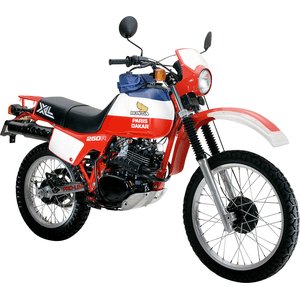Honda XL 250 R [1983–1987]: The Dual-Sport Workhorse That Refuses to Retire
Introduction
When Honda introduced the XL 250 R in the early 1980s, it wasn’t just launching another motorcycle—it was cementing a legacy. This air-cooled single-cylinder dual-sport became a benchmark for riders who demanded versatility, reliability, and simplicity. Even by modern standards, the XL 250 R remains a compelling machine for adventurers who value function over frills. Having recently spent time with a meticulously maintained 1985 model, it’s clear why this generation still commands respect among vintage off-road enthusiasts and daily commuters alike.
Design & Build: Utilitarian Charm Meets Functional Geometry
The XL 250 R’s design screams “purpose.” Its high-mounted fenders, slim fuel tank, and upright riding position reflect its dual-sport DNA. The steel frame feels robust without excessive bulk, and the 124–129 kg (273–284 lbs) curb weight makes it surprisingly flickable.
Ergonomics
- Seat Height: At 860 mm (33.8 inches), the seat is accessible for riders of average height, though taller riders might find it slightly cramped during long hauls.
- Handlebars: Wide and flat, offering excellent leverage for off-road maneuvering.
- Footpegs: Rubber-coated for road comfort but serrated enough to grip boots in dirt sections.
The 10.5-liter (2.8-gallon) fuel tank is compact but efficient, delivering a realistic 200–250 km (124–155 mi) range depending on terrain.
On-Road Performance: The Commuter’s Secret Weapon
Fire up the 249 cc air-cooled engine, and you’re greeted with a throaty, mechanical bark—a reminder that this is a no-nonsense thumper. With 18–27 PS (13–20 kW) on tap, acceleration is brisk rather than blistering. The 5-speed transmission shifts with a satisfying clunk, and the 13/38 or 15/47 sprocket combinations (depending on model year) strike a balance between highway cruising and low-speed tractability.
Key Road Manners
- Cruising Comfort: Stable at 90–100 km/h (56–62 mph), though vibrations become noticeable above 7,000 RPM.
- Tire Pressure: 1.5 bar (22 psi) front and rear—soft enough to absorb bumps but firm for paved stability.
- Braking: Mechanical drum brakes front and rear require deliberate lever pressure. They won’t win races, but they’re predictable and low-maintenance.
Off-Road Capability: Where the XL 250 R Truly Shines
Dirt roads and rocky trails are this bike’s natural habitat. The 35 mm telescopic fork (290–300 mL ATF oil per leg) and twin rear shocks offer 180 mm (7.1 inches) of travel—ample for moderate jumps and washboard terrain.
Trail-Ready Features
- Ground Clearance: 265 mm (10.4 inches) lets you straddle logs and ruts confidently.
- Weight Distribution: Neutral balance makes it easy to pivot mid-corner or lift the front wheel over obstacles.
- Gearing: The 102-link chain and 13/38 sprocket combo (on earlier models) favor torque over top speed—perfect for crawling up muddy inclines.
Competition: How the XL 250 R Stacks Up
In the 1980s dual-sport arena, the Honda faced stiff rivals. Here’s how it measures up:
Yamaha XT250
- Pros: Softer suspension for trail plushness.
- Cons: Heavier at 136 kg (300 lbs) and less responsive throttle.
Suzuki DR250S
- Pros: Slightly more peak power (28 PS).
- Cons: Complex oil-cooling system adds maintenance headaches.
Kawasaki KL250
- Pros: Six-speed transmission for highway refinement.
- Cons: Less durable valve train compared to Honda’s bulletproof design.
Verdict: The XL 250 R trades outright power for rugged simplicity. It’s the tortoise in the race—slow and steady wins the reliability stakes.
Maintenance: Keeping the Legend Alive
The XL 250 R is a DIY enthusiast’s dream. Here’s what owners should prioritize:
Critical Service Intervals
- Valve Adjustments: Every 3,000 km (1,864 mi).
- Intake: 0.05 mm (0.002 in) cold.
- Exhaust: 0.10 mm (0.004 in) cold.
- Oil Changes: Every 2,000 km (1,242 mi) with SAE 10W-40 (1.5–2.0 L/qt with filter).
- Chain Care: 102- or 100-link chain requires weekly lubrication and tension checks (25–35 mm/1.0–1.4 in slack).
MOTOPARTS.store Upgrade Recommendations
- Spark Plugs: Swap stock NGK DPR9Z/DR8ES-L for iridium DR8EIX for colder starts.
- Air Filter: Upgrade to a washable foam filter for dusty trails.
- Brake Shoes: Organic compound replacements reduce drum chatter.
Conclusion: A Timeless Tool for the Practical Rider
The Honda XL 250 R isn’t about nostalgia—it’s about substance. Whether you’re threading through city traffic or exploring fire roads, this bike delivers a raw, connected riding experience that modern fuel-injected machines often sanitize. Its maintenance needs are straightforward, and with aftermarket support from MOTOPARTS.store, keeping it alive is both affordable and rewarding.
For riders who value mechanical honesty over digital dashboards, the XL 250 R remains a revelation. It’s not just a motorcycle; it’s a testament to an era when “dual-sport” meant compromise-free capability.



















